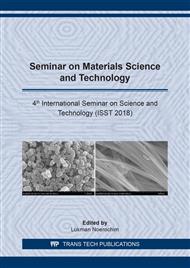p.130
p.136
p.145
p.151
p.156
p.161
p.168
p.174
p.180
Effect of Nanocellulose on Acoustical and Thermal Insulation Properties of Silicone Rubber Composite
Abstract:
Nanocellulose composites are very potential to be applied as automotive component materials.The purpose of this research is to analyze the influence of nanocellulose fraction of the silicon rubber composite material to morphology, sound absorption coefficient, density, thermal stability, and thermal conductivity. The nanocellulose of the composites were isolated from oil palm empty fruit bunch, while the matrix was silicone rubber. Tests conducted in this research included sound absorption coefficient, SEM, TGA, density, and thermal conductivity. Sound absorption coefficient had a value between 0,33 to 0.42 for a frequency of 500 Hz to 4000 Hz. This sound absorption coefficient had a wide band sound absorption tendency and was developed for sound absorption material of mufflers.
Info:
Periodical:
Pages:
156-160
Citation:
Online since:
July 2019
Keywords:
Price:
Сopyright:
© 2019 Trans Tech Publications Ltd. All Rights Reserved
Share:
Citation:


